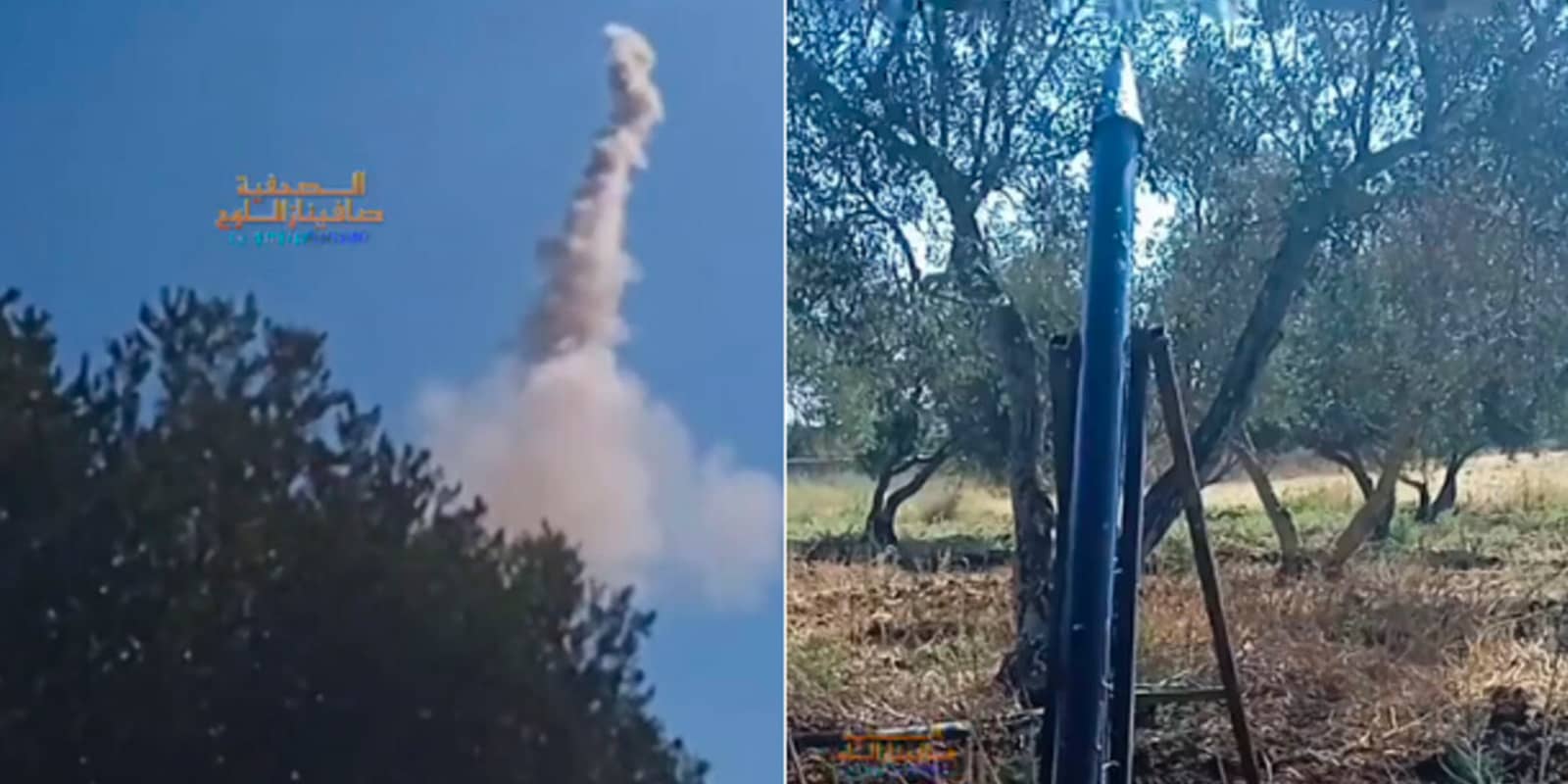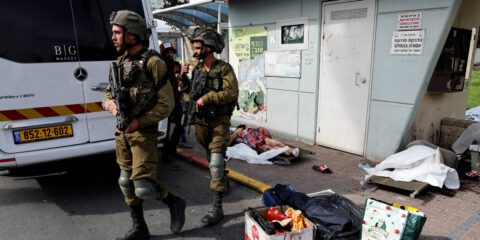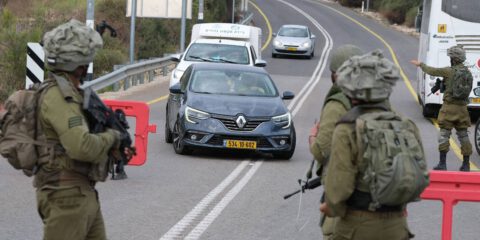What are the prospects that the terrorist organizations in Northern Samaria will acquire missile capabilities equal to those of Hamas and Palestinian Jihad in Gaza? Israel needs to prepare for what may soon transpire inside Palestinian cities.
The recent wave of Palestinian terrorist attacks against Israelis in Judea and Samaria that commenced a year ago includes an old/new tactic: the attempted launching of homemade rockets from the Jenin area toward Israeli communities in the neighboring Gilboa district.
The first incident occurred on June 26, when the local Hamas cell in Jenin announced the launching of two rockets targeting Moshav Ram On, a nearby Israeli community. Searches by the IDF uncovered rocket launchers and the remains of two rockets that fell harmlessly a few feet beyond the launchers. Seven similar incidents were reported since then, the latest on August 15. Of the eight recent incidents of rocket launching from Jenin, no casualties or damages were recorded in Israel. Nevertheless, the Palestinians having re-introduced rockets into their toolkit might be significant, heralding a growing threat to the daily routine and economic activity in Northern Israel, if not in the entire country. This article discusses the prospects of Jenin’s rocket threat growing into the proportions of the massive and deadly rocket threat from Gaza.
Jenin’s Rockets
A somewhat limited Palestinian effort to produce and fire rockets from northern Samaria toward the Mount Gilboa communities occurred during the Second Intifada, with the final rocket launch in 2008[i]. Why did rocket terrorism play such a minor part in the repertoire of terrorist tactics in the decade-long Second Intifada? There is no clear answer here. Perhaps the overwhelming effect of the suicide bombing within Israel’s cities and the terrorism against Israel’s transportation system overshadowed the potential impact of launching small, inaccurate rockets, the consequence of which could hardly compete with the devastating effects of mass Israeli deaths from suicide bombers.
At present, the Jenin rockets are simple and can be quickly produced in any moderately equipped machine shop. The rocket fuselage is made of commercial-grade steel pipes available from any lumberyard. The front dome and the nozzle can be worked on simple lathes, and the propellant can be produced from foodstuff and fertilizers, widely available in any supermarket or agriculture goods store. The plans for simple launchers and instructions on “how to cook” simple propellants are available online. Many Western countries, mainly the US and Australia, have numerous Rocket enthusiast clubs that design, build, and fly homemade rockets as a hobby. Some of those clubs publish tips and formulas on how to mix simple rocket fuel and how to build your own rocket. This information is accessible to the general public. Even if there was a way to block such inadvertent proliferators’ websites, the much more detailed know-how accumulated by Jenin’s terrorist parent organizations – Hamas and Islamic Jihad in Gaza – is available to them.
The evolution of the rocket threat from Gaza
At the outset of the Second Intifada in late 2000, the Palestinian terrorist organization in Gaza had been challenged to match the contact terrorist attacks (i.e., direct shooting of Israelis) and the suicide bombing campaign of their sibling terrorist organizations in the West Bank. That was because even at such an early date – the year 2000 – the Gaza Strip was surrounded by a border fence patrolled by the IDF, with control points checking all traffic in and out. At the same time, an extensive network of Israeli communities envelopes the Gaza Strip, some touching the Gaza border. These two factors – the enclosure of the Gaza Strip combined with the proximity of Jewish “Settlements” within and closely outside the Gaza border – probably motivated the Gaza Palestinians to turn to rockets as an effective tool for terror. With the simple rockets of the time being lightweight and easy to move about, launching them from orchards or natural vegetation covers far away from the manufacturing site was possible. At the same time, the impact of even a small rocket’s light warhead inside an Israeli community could cause a terrorized effect far more extensive than is warranted by the small amounts of explosives involved.
It stands to reason that the terrorist groups in Jenin and other Samaria cities are well acquainted with these considerations. Hence, their efforts to adapt rockets as a significant tool in their arsenal can be expected to only grow with time.
The history of rocket terrorism from Gaza consists of three phases. In the first phase – roughly from 2001 to 2007 – the Palestinians used mostly simple homemade rockets dubbed by Israelis as “Kassams.” The know-how to design and produce them came mainly from internet sites. Initially, the Gaza homemade rockets were short-range and highly unreliable. The first rocket to hit the town of Sderot (about 2 km. from the Gaza borderline) fell in October 2011, but it took almost two and a half years until the Gaza rockets became potent enough to cause fatalities (June 2004). The range and lethality of the Gaza homemade rockets continually increased after that, causing more deaths and damages in the Gaza Envelope communities.
The second stage in the Gaza rocket threat evolution commenced in 2007, following the Hamas gaining complete control of the Gaza Strip. Despite Israel’s closure of all border crossing points between Israel and Gaza and the partial closure of the Egypt-Gaza border, the Palestinians smuggled factory-made Grad rockets, probably through tunnels surreptitiously dug under the Egyptian border line. That increased the reach of the rocket threat from a few kilometers to 20, which now covered larger Israeli cities like Ashkelon. Attempts to smuggle Grad and other rockets by sea routes were frustrated, as in the case of the SS Karin A, a cargo ship chockfull of rockets and other weapons that was stopped and boarded by the Israeli Navy while steaming toward the Gaza Strip[ii]. Nevertheless, the Palestinians smuggled in improved Grads with a more than 40 km. range, allowing them to attack major Israeli cities, including Ashdod and Beersheba.
The second stage also saw a shift in the basing and launching methods of the Gaza rockets. The homemade Kassam rockets were light and easily transported by hand to remote launching sites, usually inside orchards or other areas of thick vegetation to hide from Israel’s constantly patrolling drones. The larger and heavier smuggled Grads were less mobile; hence, the terrorist organization gradually shifted to local basing in well-camouflaged underground launching pits, dug in the courtyards of private homes and in busy public spaces, to exploit the constant presence of residents as human shields.
The third phase commenced around the time of Operation Protective Edge in 2014 when the Iranians replaced their policy of shipping completed rockets to their regional proxies with a policy of providing them with the materials, expertise, and means of production to set up their own rocket factories inside their enclaves.
Thus, the Gaza terrorist organizations reverted to locally made rockets in an infinitely more sophisticated manner. The home kitchens and simple workshops were replaced with well-equipped long-range rockets and multiple launcher industries. The simple fuels of the past were replaced by modern high-performance propellants based on modern, military-grade precursor materials. The rocket’s range increased by dozens and even hundreds of kilometers, and warheads grew from a few kg. to tens and sometimes more than a hundred kilograms. The larger and heavier rockets produced in the new, largely underground “Gaza Military Industry” plants required bigger and heavier launchers, some so large that they could not be buried in underground launching bunkers but above ground sites under heavy camouflage. Today, the range of the Gaza rockets covers the entire territory of Israel. Every escalation cycle since Pillar of Defense in 2012 saw rocket attacks from Gaza on Tel Aviv, Jerusalem, and sometimes even Haifa.
The key to the success of the “Gaza Military Industry” was the massive Iranian supply of machinery and the building up a cadre of local rocket manufacturing experts by flying them to Iran and training them inside Iran’s rocket industries. [iii] Moreover, the Gaza terrorist groups managed to obtain the willing collaboration of a Jamal El Zebada, a world-renowned US trained rocket engineer. A graduate of a prestigious American technological institute who worked in major US aerospace industries, El Zebada became the technical director of the Gaza Military Industries upon returning to his native city of Gaza (El Zebada and most of his senior team were killed during Operation Breaking Dawn in May 2021). [iv]
This third phase in the evolution of the Gaza rocket threat continues to this day, characterized by “bursts” of escalation cycles lasting days or weeks that end in fragile ceasefires usually negotiated by the Egyptian government.
Another aspect of the evolution of the rocket threat from Gaza is the timeline of the growing intensity of the rocket fire. Here, once more, we can distinguish between three periods.
The first, from 2001 to mid-2005, saw a relatively low rate of fire of about 50 rockets per year. During this period, parts of the Gaza Strip were ruled by the Palestinian Authority, and the IDF had the freedom of action in the Israeli-controlled regions of the Strip. The second phase occurred between mid-2005 and mid-2007 – that is, between Israel’s unilateral pullback from Gaza and the seizure of power there by the Hamas. In this stage, the rate of fire doubled to about 200 rockets per year. The third period, commencing in mid-2007 and lasting to this day, overlaps with the absolute Hamas control of the Gaza Strip (in conjunction with the Islamic Jihad). As soon as Hamas evicted the PA from Gaza, the rate of rocket fire made quantum leaps to hundreds and then thousands of rockets per year. [v]
Following the first mortalities from rocket fire in the town of Sderot in June 2004, the IDF took forceful action to suppress the rocket fire and launched the 17-day Operation Repentance Days, during which it entered the Palestinian-controlled regions of the Gaza Strip while the Israeli Air Force hunted Palestinian rocket teams in the open. Despite this strenuous effort, the Palestinians never ceased to fire rockets during the Israeli operation and managed to hit civilians inside Israel.
After the unilateral disengagement from Gaza, the IDF launched five additional operations against the Gaza rockets, the most extensive being Operation Cast Lead in 2009. That strategy brought a temporary decline of the missiles fired from Gaza, which was reversed in 2014, following a chain of events commencing with the murder of three Israeli youths south of Jerusalem. It then escalated to a major rocket campaign from Gaza on major cities in Israel, followed by Israel’s Operation Protective Edge in July, which saw more than 4,000 rockets and mortar bombs fired during the 50-day campaign.
Will the Gaza pattern repeat itself in Northern Samaria?
What are the prospects that the terrorist organizations in Northern Samaria – Jenin, Nablus, or other cities – will acquire capabilities equal to those of Hamas and Palestinian Jihad in Gaza?
Presently, the terrorist organizations’ capabilities in the Jenin district are more or less equivalent to Gaza’s capabilities in the early 2000s, namely the capacity to manufacture simple rockets in the private machine shops in Jenin and other Palestinian communities. Israel would like to return the genie to the bottle somehow – that is, to roll back even this rudimentary rocket production capability. Judging by the Gaza precedent, this seems nearly impossible. As noted above, even the presence of IDF boots on the ground inside Gaza could not prevent the terrorists there from producing a limited amount of simple, kitchen-made yet lethal rockets. It should be noted that when the first victims of Gaza rockets died in Sderot in June 2004, the disengagement was still 14 months away, and the IDF enjoyed freedom of action in parts of the Gaza Strip.
Hence, it stands to reason that the terrorist groups in Jenin and neighboring cities will continue to manufacture and launch their local version of Kassams in growing numbers, quality, and range – which eventually will cause damage and casualties in nearby Israeli communities. The initiative whether to do so will remain with the terrorists. If they focus their activities on contact operations (i.e., assassinations of Israelis by gunfire) as they are doing now or add suicide bombing to their repertoire (none recorded yet, at the time of this writing), their motivation to invest serious effort in rocket production might be muted.
As for their capability to shift to Phase 2 and import completed military-grade rockets and launchers, this is not impossible under present conditions. Palestinians in the West Bank enjoy freedom of movement with no Israeli control of the contents of shipments within that region. In this situation, it stands to reason that there will be attempts to smuggle completed Grad or Grad-equivalent rockets and launchers’ shipped from Lebanon or Iran through Jordan to Jenin and other Palestinian cities. If successful, the terrorist organizations – like their Gaza predecessor – may shift their launch sites from open areas outside their cities to concealed launching pits inside them. To this end, the terrorists will more likely dig a network of tunnels under the densest regions of their cities to hide the rockets and provide for their concealed transportation to the launching pits.
The geographic and geological differences between Samaria and Gaza should be noted. The Gaza Strip sits on sandy soil, which facilitates underground digging. In contrast, Jenin and the other Samaria cities are on hard ground of limestone rock. That, in turn, makes underground digging more difficult but not impossible. It stands to reason that with high-powered excavating and drilling tools, the Jenin terrorists will eventually be able to dig tunnels, storage sites, and rocket-launching pits. Note that following the IDF’s incursion into Jenin in June, the terrorists there published images of an already existing tunnel that they had dug up before the incursion, which the IDF failed to locate. [vi]
In the case of Gaza, the transition from the first to the second phase of the threat – from locally home-produced rockets to imported military-grade rockets – happened when the IDF had already vacated the Gaza Strip. In contrast, the IDF maintains a significant presence in Samaria. It stands to reason that once smuggled military-grade rockets become known, the IDF will act energetically to block the smuggling routes and shut down depots and launching pits inside the Palestinian cities. This, in turn, will require the denial of Palestinian freedom of movement, the return to the roadblock system of the Second Intifada, as well as frequent incursions on the ground into the center of the Palestinian cities and refugee camps – all at a high political cost in the international arena. While such measures may not prevent a Phase 2 rocket threat from Jenin and neighboring Palestinian cities, they could minimize its scale and consequences.
It is not inconceivable that the terrorists and their Iranian sponsors might aspire to move directly from Phase 1 to Phase 3, from kitchen-grade rockets to producing quality, long-range rockets in advanced production lines manned by well-trained local operators. The template for this exists today in the Gaza Strip.
To implement such a quantum leap in rocket production capability in Jenin, the Iranians will have to smuggle advanced machinery, raw materials and rocket propellant precursor chemicals into the city. Manpower training need not be in Iran, as happened in Gaza. Instead, it could be facilitated by expert instructors from Gaza. On their side, the Jenin terrorists will have to excavate vast underground production, storage, transportation, and launching facilities. Such extensive activity is unlikely to remain completely concealed. More probable, such vast efforts will become known to Israel’s intelligence agencies well before the “Jenin Military Industries” reaches maturity.
Thus, if the IDF maintains its military presence in the West Bank, it can be assumed that the Palestinian efforts to set up a rocket industry will be met by energetic Israeli efforts to frustrate the enterprise – again, by controlling traffic in and out of the Palestinian cities and by repeated raids on suspected rocket production and launching sites. It is quite likely that such Israeli countermeasures will hinder, if not completely prevent, the establishment of a fully operational Jenin Military Industries. In the case of Gaza, the IDF had no boots on the ground to block the establishment of the Gaza Military Industries.
In contrast, if there is no unilateral disengagement from the West Bank or part of it, the IDF will have the capacity to impede or even prevent the establishment of a Gaza-like rocket industry in Jenin or other cities in Samaria. There will, however, be a steep political price to pay for that.
Conclusions
One can derive some conclusions and recommendations from the above arguments.
- It is impossible to return the genie to the bottle and prevent the terrorists in Jenin from manufacturing and launching simple homemade rockets.
- At the same time, it is possible to limit the scale of the rocket threat from Jenin to well below that of Gaza, provided that the IDF continues to maintain a strong presence in the West Bank and that Israel is ready to pay the political penalty in the international arena for limiting the threat to its citizens inside Israel.
- It is recommended that some preparatory steps be taken as soon as possible to prepare the Jenin Envelope communities – Israeli towns in Samaria near Jenin – for a potential Phase 1 rocket threat, like the one faced by the Gaza Envelope communities in the early 2000s. That might include briefing communal leadership, building individual and communal shelters, and providing early warning systems, like the Code Red system around Gaza.
[i] Shragai, N. Don’t trivialize it: the rocket threat from Samaria could bring Gaza to the center of Israel. Israel Today August 2, 2023
https://www.israelhayom.co.il/magazine/hashavua/article/14454452
[ii]Ben David, S. 20 years after the capturing of the Karin A: In this operation, we perceived the meaning of the phrase “To defend home and hearth,” Maariv, December 12, 2022
https://www.maariv.co.il/news/military/Article-891104
[iii] ”Did Iran Train Gaza Rocket Maker?” Al Monitor, 17.7.2014 10
http://www.al-monitor.com/pulse/originals/2014/07/gaza-rockets-palesƟne-iranself-sufficient.html
[iv] Rubin, U. Israel’s Air and Missile Defense Challenged in Operation Guardian of the Wall, The Jerusalem Institute for Strategy and Security, August 7, 2021 (In Hebrew)
https://jiss.org.il/he/rubin-israels-air-defense-tested-during-operation-wall-guard
[v] Rubin, U The Missile Threat from Gaza: From Nuisance to Strategic Threat, The Begins Sadat Center for Strategic Studies, Mideast Security and Policy Studies No. 91, December 2011, Pp 27
https://besacenter.org/wp-content/uploads/2011/01/MSPS87.pdf
[vi] Zeitun, Y, Halbi, A and Moshkovitch, Y: A Rocket Was Fired from Jenin, An Exceptional Disclosure: A tens of meters long tunnel under the (Jenin) refugee camp, YNET July 27, 2023
https://www.ynet.co.il/news/article/s1vy11ayo2
JISS Policy Papers are published through the generosity of the Greg Rosshandler Family.
Photo: from social media









 - בניית אתרים
- בניית אתרים